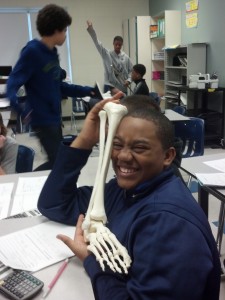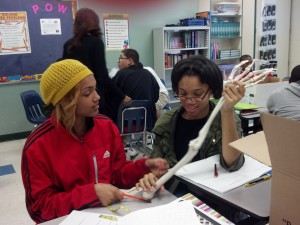

Inquiry based learning, What is it?
Inquiry is generally considered as a formalized asking or an investigation through questioning. Research is the means by which we can systematically answer these questions by tapping into the body of literature and research that has come before. Through research (scientific or literature reviews), we test theories, discover ideas, generate new thoughts or hypotheses and create new solutions to problems.
Because of the post-industrial information age in which we are living, it is ever more important that students learn how to ask important questions, find answers to those questions to create new content and participate in the global conversation in meaningful and intentional ways. It is critical that students have regular opportunities to ask questions and have the time and resources to dig deeply enough into these questions to be able to create new understandings and content worth sharing.
Guided Inquiry Design supports students to learn the content of the course, curriculum or unit through inquiry and research. The process supports students to learn how they learn through inquiry. The collaborative learning team provides the underpinnings needed connecting to standards and curricula in order to design learning experiences that support students to construct their own understandings.
Collaborative Teams
The learning teams collaborate and design learning experiences for students that address core literacy, content, and social learning outcomes. Through teacher collaborations with school librarians, information literacy skills are taught within an authentic context using the Guided Inquiry process providing students with “the why” alongside “the how.” Students learn about information literacy concepts and resources, as they need them, to answer their real questions about what they are learning. This promotes deeper learning and transfer of these skills and knowledge to other situations.
A new study out recognizes how teacher collaboration boosts deeper learning (Ronfeldt, Farmer, McQueen & Grissom, 2015).
Norman Public School teacher/teacher librarian team designing a unit of study at a Guided Inquiry Institute
Learning How to Learn
People are recognizing a great need to provide students with structured opportunities to reflect on how they learn through inquiry and research (Jacobson & O’Keefe 2014). Guided Inquiry includes regular self-reflection on student’s thoughts, feelings and actions as they go through the phases of inquiry.
Implications from the research on the ISP show that students benefit from guidance during research, especially when students are learning about the process (K-12). The Information Search Process indicates specific areas where, without guidance or knowledge of the process, many students may give up finding the deeper knowledge on their own, as they may get frustrated exploring the vast amount of information (Kuhlthau, 2004).
It is important for schools to support students to understand and recognize the inquiry process so that they may become independent to search for deeper meaning. This deeper understanding of “how I learn” through my own deep questions is a key component of a skill set for participation in the digital landscape, to enhance life, citizenry and grow academic abilities.
In Guided Inquiry Design we include embedded inquiry tools throughout the phases of inquiry to support students’ meta-cognition about learning how to learn through inquiry so that students who participate can know the process and become flexible and independent in their use of tools and strategies that support them to dig deeply to answer their questions.
Core Content through Inquiry
In a school dedicated to deeper learning, Guided Inquiry is the main approach to learning curricular content in science and humanities. An inquiry approach fits schools that employ educators who believe in a constructivist pedagogy (Kuhlthau 2004). In general, constructivist agree that humans learn through constructing their own understanding, not through “give and get” learning scenarios. Inquiry learning is active. Students are full participants in the learning as they ask questions and wonder. They are not considered passive recipients of knowledge. Inquiry learning requires students to construct understandings, participate, actively question, think, connect ideas as they grow an academic mindsets. The most effective classroom model for a constructivist approach is the workshop model. Guided Inquiry uses a workshop model for inquiry.

 Students in Newport News Virginia enjoying learning content through the Guided Inquiry process
Students in Newport News Virginia enjoying learning content through the Guided Inquiry process
Social Context
Inquiry learning includes individual knowledge construction within a social context of learning. Each individual student constructs their own understanding as ideas and concepts are connected to what students know about the world. Misconceptions are addressed and sorted out through a social context and discussion within small groups, pairs, and within the inquiry community.
School-Based Instructional Design
In working with teachers across the country, we have found that teachers with a canned program of lessons must still spend time unpacking those lessons to effectively teach them to their students. These canned programs can tout that they address Common Core and other curricula and standards, but teachers still have to break these lessons down in their planning to effectively teach them to their students.
Teachers at the school level know the students, what they know, and what content requires proficiency. This core team can design meaningful units of study having a greater impact on student learning. When learning is intentionally designed in this way teacher and student engagement is heightened and relevance is clearly made. In this way Guided Inquiry gives the teachers control over what is being taught and how it is taught. Teams are more able to plan effective lessons out of that design.
With the knowledge of Guided Inquiry Design and theory, educators in collaborative teams can map out concepts, knowledge and skills that are addressed across the course, unit, term or even year. Together they determine the big picture concepts that all students will come away with and identify the learning objectives that support all five kinds of learning through the study.
The team together determines formative assessments of progress along these learning targets. The assessments are determined in the design of the inquiry and used to track students meta-cognitive learning about how they are learning as well as literacy development, understanding of content goals, information literacy skills and concepts as well as growth in social contexts. Schools that use this approach need to provide teachers the time to design learning experiences that will support students learning goals.
Informal studies of teams that I have worked with have compared results of traditionally taught material to that of students who learned through their carefully planned Guided Inquiry Designs. The results from these teams were worth noting. Students learning through Guided Inquiry Design performed much better on end of unit tests and state standardized tests on the same content following the study.
Leslie Maniotes
References and Resources:
Kuhlthau, C. (2004) Seeking Meaning.
Kuhlthau, Maniotes & Caspari Guided Inquiry Design (2012) Guided Inquiry: Learning in the 21st Century (2015)
Maniotes, Harrington & Lambusta Guided Inquiry Design in Action: Middle School (2016)
Mills, H., OKeefe, T., Hass, C. and Johnson, S. Changing Hearts, Minds, and Actions through Collaborative Inquiry Language Arts, September 2014, Vol. 92, No.1, pp. 36-51. (http://www.ncte.org/library/nctefiles/resources/journals/la/0921-sep2014/la0921changing.pdf)
Ronfeldt, M; Owens Farmer, S., McQueen, K., Grissom, J. A., Teacher Collaboration in Instructional Teams and Student Achievement American Educational Research Journal June 2015, Vol. 52, No. 3, pp. 475–514. (http://m.aer.sagepub.com/content/52/3/475.full.pdf)